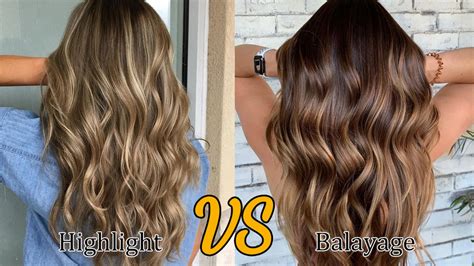Balayage and highlights are both popular hair coloring techniques, but they offer different benefits and suit different styles.

What is Highlight?
Highlighting is a hair coloring technique that involves lightening strands of hair with bleach or hair dye, creating a more natural-looking, sun-kissed effect.
What is Balayage?
Balayage is a freehand painting technique that involves applying bleach or hair dye to the hair’s surface, creating a more gradual, blended look with softer, less defined lines.
## Highlights vs Balayage: Which is Right for You?
1. The Desired Effect
- Highlights: Create a more natural, sun-kissed look with defined, contrasting strands.
- Balayage: Produce a more blended, subtle effect with less noticeable lines of demarcation.
2. Hair Texture:
- Highlights: Suitable for all hair textures, but may be more noticeable on thicker hair.
- Balayage: Ideal for fine or medium hair, as it can add volume and dimension without weighing down the hair.
3. Maintenance:
- Highlights: Require more frequent touch-ups as the roots grow out, typically every 6-8 weeks.
- Balayage: Lower maintenance, with touch-ups needed less frequently, usually every 10-12 weeks.
4. Cost:
- Highlights: Generally more expensive than balayage due to the more labor-intensive process.
- Balayage: Less expensive, as it takes less time and product to create.
### 5. Styling:
– Highlights: Can add depth and dimension to hair, making it easier to style and create different looks.
– Balayage: Provides a natural-looking base color that can be easily styled with curls, waves, or straight hair.
6. Hair Health:
- Highlights: Can be more damaging to hair as bleach is used, potentially leading to breakage.
- Balayage: Less damaging as bleach is not applied to the entire head, preserving the health of the hair.
The best hair coloring technique for you depends on your desired effect, hair texture, maintenance preferences, budget, and hair health goals. Consider the following factors when making your decision:
1. Desired Effect: Natural vs. Dramatic
- Highlights: Natural, sun-kissed look
- Balayage: Blended, subtle effect
2. Hair Texture: Fine vs. Thick
-Highlights: Suitable for all textures
– Balayage: Ideal for fine or medium hair
3. Maintenance: Frequent vs. Infrequent
- Highlights: More frequent touch-ups
- Balayage: Less frequent touch-ups
4. Cost: Expensive vs. Budget-friendly
- Highlights: More expensive
- Balayage: Less expensive
5. Styling: Versatile vs. Effortless
- Highlights: Adds depth and dimension
- Balayage: Natural-looking base color for easy styling
6. Hair Health: Bleaching vs. Blending
- Highlights: More damaging (bleach)
- Balayage: Less damaging (no bleach on entire head)
1. Your Skin Tone:
- Warm skin tones: Suit golden or caramel highlights and balayage tones.
- Cool skin tones: Flatter ash or platinum highlights and balayage shades.
2. Your Hair Color:
- Dark hair: Highlights or balayage can add brightness and dimension.
- Light hair: Highlights or balayage can enhance natural tones or create subtle color changes.
3. Your Hair Length:
- Short hair: Highlights or balayage can add texture and movement.
- Long hair: Highlights or balayage can create depth and dimension throughout the length.
4. Your Lifestyle:
- Active lifestyle: Balayage may be more suitable due to its lower maintenance.
- Formal or professional: Highlights may be more appropriate for a polished look.
5. Your Budget:
-
Tight budget: Balayage is generally more cost-effective than highlights.
–Willing to spend: Highlights can provide a more noticeable transformation.
